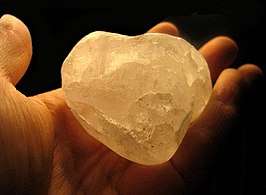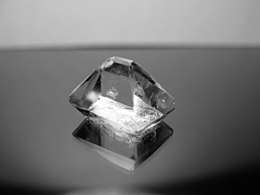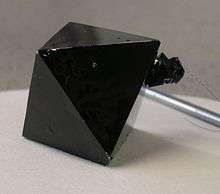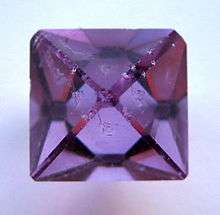Alum
An alum (/ˈæləm/) is a type of chemical compound, usually a hydrated double sulfate salt of aluminium with the general formula XAl(SO
4)
2·12H
2O, where X is a monovalent cation such as potassium or ammonium.[1] By itself, "alum" often refers to potassium alum, with the formula KAl(SO
4)
2·12H
2O. Other alums are named after the monovalent ion, such as sodium alum and ammonium alum.

4)
2·12H
2O.
The name "alum" is also used, more generally, for salts with the same formula and structure, except that aluminium is replaced by another trivalent metal ion like chromium(III), and/or sulfur is replaced by another chalcogen like selenium.[1] The most common of these analogs is chrome alum KCr(SO
4)
2·12H
2O.
In most industries, the name "alum" (or "papermaker's alum") is used to refer to aluminium sulfate Al
2(SO
4)
3·nH
2O, which is used for most industrial flocculation. In medicine, "alum" may also refer to aluminium hydroxide gel used as a vaccine adjuvant.[2]
History
In antiquity and the Middle Ages
Alum found at archaeological sites
The western desert of Egypt was a major source of alum substitutes in antiquity. These evaporites were mainly FeAl
2(SO
4)
4·22H
2O, MgAl
2(SO
4)
4·22H
2O, NaAl(SO
4)
2·6H
2O, MgSO
4·7H
2O and Al
2(SO
4)
3·17H
2O.[3]
The production of potassium alum from alunite is archaeologically attested on the island Lesbos.[4] This site was abandoned in the 7th century but dates back at least to the 2nd century CE. Native alumen from the island of Melos appears to have been a mixture mainly of alunogen (Al
2(SO
4)
3·17H
2O) with potassium alum and other minor sulfates.[5]
Alumen in Pliny and Dioscorides
A detailed description of a substance called alumen occurs in Pliny the Elder's Natural History.[6]
By comparing Pliny's description with the account of stupteria given by Dioscorides,[7] it is obvious the two are identical. Pliny informs us that a form of alumen was found naturally in the earth, and calls it salsugoterrae.
Pliny wrote that different substances were distinguished by the name of alumen, but they were all characterised by a certain degree of astringency, and were all employed in dyeing and medicine.[6] Pliny says that there is another kind of alum that the Greeks call schiston, and which "splits into filaments of a whitish colour",[6] From the name schiston and the mode of formation, it appears that this kind was the salt that forms spontaneously on certain salty minerals, as alum slate and bituminous shale, and consists chiefly of sulfates of iron and aluminium. One kind of alumen was a liquid, which was apt to be adulterated; but when pure it had the property of blackening when added to pomegranate juice. This property seems to characterize a solution of iron sulfate in water; a solution of ordinary (potassium) alum would possess no such property. Contamination with iron sulfate was greatly disliked as this darkened and dulled dye colours. In some places the iron sulfate may have been lacking, so the salt would be white and would be suitable, according to Pliny, for dyeing bright colors.
Pliny describes several other types of alumen but it is not clear as to what these minerals are. The alumen of the ancients, then, was not always potassium alum, not even an alkali aluminum sulfate.[8]
Alum described in medieval texts
Alum and green vitriol (iron sulfate) both have sweetish and astringent taste, and they had overlapping uses. Therefore, through the Middle Ages, alchemists and other writers do not seem to have discriminated the two salts accurately from each other. In the writings of the alchemists we find the words misy, sory, and chalcanthum applied to either compound; and the name atramentum sutorium, which one might expect to belong exclusively to green vitriol, applied indifferently to both.
Alum was the most common mordant used in the dye industry in the Islamic middle ages. It was the main export of the Chad region, from where it was transported to the markets of Egypt and Morocco, and then on to Europe. Other, less significant, sources were found in Egypt and Yemen.[9]
Modern understanding of the alums
In the early 1700s, Georg Ernst Stahl claimed that reacting sulfuric acid with limestone produced a sort of alum.[10][11] The error was soon corrected by Johann Pott and Andreas Marggraf, who showed that the precipitate obtained when an alkali is poured into a solution of alum, namely alumina, is quite different from lime and chalk, and is one of the ingredients in common clay.[12][13]
Marggraf also showed that perfect crystals with properties of alum can be obtained by dissolving alumina in sulfuric acid and adding potash or ammonia to the concentrated solution.[14][15] In 1767, Torbern Bergman observed the need for potassium or ammonium sulfates to convert aluminium sulfate into alum, while sodium or calcium would not work.[14][16]
The composition of common alum was finally determined by Louis Vauquelin in 1797. As soon as Martin Klaproth discovered the presence of potassium in leucite and lepidolite,[17][18] Vauquelin demonstrated that common alum is a double salt, composed of sulfuric acid, alumina, and potash.[19] In the same journal volume, Jean-Antoine Chaptal published the analysis of four different kinds of alum, namely, Roman alum, Levant alum, British alum and alum manufactured by himself,[20] confirming Vauquelin's result.[14]
Production
Some alums occur as minerals, the most important being alunite.
The most important alums – potassium, sodium, and ammonium – are produced industrially. Typical recipes involve combining aluminium sulfate and the sulfate monovalent cation.[21] The aluminium sulfate is usually obtained by treating minerals like alum schist, bauxite and cryolite with sulfuric acid.[22]
Types

Aluminium-based alums are named by the monovalent cation. Unlike the other alkali metals, lithium does not form alums; a fact attributed to the small size of its ion.
The most important alums are
- Potassium alum, K(SO
4)
2Al(SO
4)
3·24H
2O, also called "potash alum" or simply "alum". - Sodium alum, NaAl(SO
4)
2·12H
2O, also called "soda alum" or "SAS". - Ammonium alum, NH
4Al(SO
4)
2·12H
2O.
Chemical properties
Aluminium-based alums have a number of common chemical properties. They are soluble in water, have a sweetish taste, react acid to litmus, and crystallize in regular octahedra. In alums each metal ion is surrounded by six water molecules. When heated, they liquefy, and if the heating is continued, the water of crystallization is driven off, the salt froths and swells, and at last an amorphous powder remains.[14] They are astringent and acidic.
Crystal structure
Alums crystallize in one of three different crystal structures. These classes are called α-, β- and γ-alums. The first x-ray crystal structures of alums were reported in 1927 by James M. Cork and Lawrence Bragg, and were used to develop the phase retrieval technique isomorphous replacement.[23]
Solubility
The solubility of the various alums in water varies greatly, sodium alum being readily soluble in water, while caesium and rubidium alums are only sparingly soluble. The various solubilities are shown in the following table.[22]
At temperature T, 100 parts water dissolve:
| T | Ammonium alum | Potassium alum | Rubidium alum | Caesium alum |
|---|---|---|---|---|
| 0 °C | 2.62 | 3.90 | 0.71 | 0.19 |
| 10 °C | 4.50 | 9.52 | 1.09 | 0.29 |
| 50 °C | 15.9 | 44.11 | 4.98 | 1.235 |
| 80 °C | 35.20 | 134.47 | 21.60 | 5.29 |
| 100 °C | 70.83 | 357.48 |
Uses
Aluminium-based alums have been used since antiquity, and are still important in many industrial processes. The most widely used alum is potassium alum. It has been used since antiquity as a flocculant to clarify turbid liquids, as a mordant in dyeing, and in tanning. It is still widely used in the treatment of water, in medicine, for cosmetics (in deodorant), in food preparation (in baking powder and pickling), and to fire-proof paper and cloth.
Alum is also used as a styptic, in styptic pencils available from pharmacists, or as an alum block, available from barber shops and gentlemen's outfitters, to stem bleeding from shaving nicks;[24] and as an astringent. An alum block can be used directly as a perfume-free deodorant (antiperspirant), and unprocessed mineral alum is sold in Indian bazaars for just that purpose. Throughout Island Southeast Asia, potassium alum is most widely known as tawas and has numerous uses. It is used as a traditional antiperspirant and deodorant, and in traditional medicine for open wounds and sores. The crystals are usually ground into a fine powder before using.[25][26]
Alum is used as a mordant in traditional textiles;[27] and in Indonesia and the Philippines, solutions of tawas, salt, borax, and organic pigments were used to change the color of gold ornaments.[28] In the Philippines, alum crystals were also burned and allowed to drip into a basin of water by babaylan (shamans) for divination. It is also used in other rituals in the animistic anito religions of the islands.[29][30][31][32]
In traditional Japanese art, alum and animal glue were dissolved in water, forming a liquid known as dousa (ja:礬水), and used as an undercoat for paper sizing.
Alum in the form of potassium aluminium sulphate or ammonium aluminium sulfate in a concentrated bath of hot water is regularly used by jewelers and machinists to dissolve hardened steel drill bits that have broken off in items made of aluminum, copper, brass, gold (any karat) and silver (both sterling and fine). This is because alum does not react chemically to any significant degree with any of these metals, but will corrode steel. When heat is applied to an alum mixture holding a piece of work that has a drill bit stuck in it, if the lost bit is small enough, it can sometimes be dissolved / removed within hours.[33]
Related compounds

Many trivalent metals are capable of forming alums. The general form of an alum is XM(SO4)2·nH2O, where X is an alkali metal or ammonium, M is a trivalent metal, and n often is 12. The most important example is chrome alum, KCr(SO
4)
2·12H
2O, a dark violet crystalline double sulfate of chromium and potassium, was used in tanning.
In general, alums are formed more easily when the alkali metal atom is larger. This rule was first stated by Locke in 1902,[34] who found that if a trivalent metal does not form a caesium alum, it neither will form an alum with any other alkali metal or with ammonium.
Selenate-containing alums
Selenium or selenate alums are also known that contain selenium in place of sulfur in the sulfate anion, making selenate (SeO2−
4) instead.[35] They are strong oxidizing agents.
Mixed alums

In some cases, solid solutions of alums with different monovalent and trivalent cations may occur.
Other hydrates
In addition to the alums, which are dodecahydrates, double sulfates and selenates of univalent and trivalent cations occur with other degrees of hydration. These materials may also be referred to as alums, including the undecahydrates such as mendozite and kalinite, hexahydrates such as guanidinium (CH
6N+
3) and dimethylammonium ((CH
3)
2NH+
2) "alums", tetrahydrates such as goldichite, monohydrates such as thallium plutonium sulfate and anhydrous alums (yavapaiites). These classes include differing, but overlapping, combinations of ions.
Other double sulfates
A pseudo alum is a double sulfate of the typical formula ASO
4·B
2(SO
4)
3·22H
2O, where A is a divalent metal ion, such as cobalt (wupatkiite), manganese (apjohnite), magnesium (pickingerite) or iron (halotrichite or feather alum), and B is a trivalent metal ion.[36]
Double sulfates with the general formula A
2SO
4·B
2(SO
4)
3·24H
2O are also known, where A is a monovalent cation such as sodium, potassium, rubidium, caesium, or thallium(I), or a compound cation such as ammonium (NH+
4), methylammonium (CH
3NH+
3), hydroxylammonium (HONH+
3) or hydrazinium (N
2H+
5), B is a trivalent metal ion, such as aluminium, chromium, titanium, manganese, vanadium, iron(III), cobalt(III), gallium, molybdenum, indium, ruthenium, rhodium, or iridium.[37] Analogous selenates also occur. The possible combinations of univalent cation, trivalent cation, and anion depends on the sizes of the ions.
A Tutton salt is a double sulfate of the typical formula A
2SO
4·BSO
4·6H
2O, where A is a univalent cation, and B a divalent metal ion.
Double sulfates of the composition A
2SO
4·2BSO
4, where A is a univalent cation and B is a divalent metal ion are referred to as langbeinites, after the prototypical potassium magnesium sulfate.
See also
- Alunite
- List of minerals
- Gum bichromate - photo prints and other similar processes use alums, sometimes as colloid (gelatin, albumen) hardeners
References
- Austin, George T. (1984). Shreve's Chemical process industries (5th ed.). New York: McGraw-Hill. p. 357. ISBN 9780070571471.
- "Alhydrogel | Alum vaccine adjuvant for research | InvivoGen". www.invivogen.com. Retrieved 2018-06-08.
- Picon, M.; et al. (2005). "L'alun des oasis occidentales d'Egypte: researches sur terrain et recherches en laboratoire". In Borgard P.; et al. (eds.). L'alun de Mediterranée.
- Archontidou, A. (2005). "Un atelier de preparation de l'alun a partir de l'alunite dans l'isle de Lesbos". In Borgard P.; et al. (eds.). L'alun de Mediterranée.
- Hall, A. J.; Photos-Jones, E. (2005). "The nature of Melian alumen and its potential for exploitation in Antiquity". In Borgard P.; et al. (eds.). L'alun de Mediterranée.
- Pliny the Elder. "Alumen, and the several varieties of it; Thirty-eight remedies". Naturalis Historia [Natural History]. Perseus Digital Library (in Latin and English). Tufts University. book 35, chapter 52. Retrieved 27 December 2011.
- Dioscorides. De Materia Medica [On Medical Materials] (in Greek and Latin). book 5, chapter 123.
- Chisholm 1911, pp. 766-767.
- Goitein, Shelomo Dov; Sanders, Paula (1967). A Mediterranean Society: Daily life. University of California Press. p. 405. ISBN 0520048695. Retrieved 22 June 2020.
- George Ernst Stahl (1703), Specimen Beccherianum. Johann Ludwig Gleditsch, Leipzig. From p. 269: "CVII. Vitriolum, Creta præcipitari potest, ut omissa metallica sua substantia, aluminosum evadat." (107. Sulfuric acid [and] chalk can [form a] precipitate, as its liberated metallic substance, alum, escapes.)
- George Ernst Stahl (1723), Ausführliche Betrachtung und zulänglicher Beweiss von den Saltzen, daß diesselbe aus einer zarten Erde, mit Wasser innig verbunden, bestehen (Detailed treatment and adequate proof of salts, that they consist of a subtile earth intimately bound with water) Wäysenhaus, Halle From p. 305: " … wie aus Kreide und Vitriole-Spiritu, ein rechter Alaun erwächset: … " ( … as from chalk and sulfuric acid, a real alum arises: … )
- Johann Heinrich Pott (1746), Chymische Untersuchungen, welche fürnehmlich von der Lithogeognosia oder Erkäntniß und Bearbeitung der gemeinen einfacheren Steine und Erden ingleichen von Feuer und Licht handeln [Chemical investigations which primarily concern lithogeognosia or knowledge and processing of common simple rocks and earths as well as fire and light]. Potsdam, (Germany), Christian Friedrich Voss, volume 1, p. 32. From p. 32:] "Concentrirt man hingegen diese solution gelinde, und läßt sie crystallisiren, so schiessen harte und mercklich adstringente und hinter her etwas süßliche crystallen an, die allen Umständen nach in der Haupt-Sach nichts anders sind als ein formaler Alaun. Diese Entdeckung ist in der physicalischen Chymie von Wichtigkeit. Man hat bishero geglaubt, die Grund-Erde des Alauns sey eine in acido Vitrioli solvirte kalckige … Erde, … " (On the other hand, if one gently concentrates this solution, and lets it crystallize, then there precipitate hard, noticeably astringent crystals with a somewhat sweet aftertaste, which in all circumstances are mainly nothing other than a form of alum. This discovery is of importance to chemistry. One had hitherto believed [that] the fundamental earth of alum is a calcareous … earth dissolved in sulfuric acid, … )
- Andreas Sigismund Marggraf (1754), "Expériences faites sur la terre d'alun" (Experiments made on the earth of alum), Mémoires de l'Académie des sciences et belles-lettres de Berlin, pp. 41-66.
- Chisholm 1911, p. 766.
- Marggraf (1754) "Expériences qui concernent la régénération de l'alun de sa propre terre, l'après avoir séparé par l'acide vitriolique ; avec quelques compositions artificielles de l'alun par moyen d'autres terres, et dudit acide" (Experiments that concern the regeneration of alum from its own earth, after having separating it by sulfuric acid ; with some artificial compounds of alum by means of other earths and the aforesaid acid), Mémoires de l'Académie des sciences et belles-lettres de Berlin, pp. 31-40.
- Torbern Bergman (1767), "IX. De confectione Aluminis". In Opuscula physica et chemica, I. G. Müller, Leipzig, 1788), volume 1. On pp. 306-307, after noting that Marggraf had noticed that potash caused alum to crystallize from a solution of alumina and sulfuric acid, Bergman adds "Notatu quoque dignum est, quod hoc cristallisationis obstaculum alcali volatili aeque tollatur, non vero alkali minerali et calce." (It is significant as well that by [use of] the volatile alkali [i.e., ammonia] this obstacle to crystallization is similarly removed, but not [in the cases of] mineral alkali [i.e., sodium carbonate] and lime.)
- Martin Heinrich Klaproth (1797), Beiträge zur Chemischen Kenntniss Der Mineralkörper (Contributions to [our] chemical knowledge of mineral substances). Decker and Co., Posen, and Heinrich August Rottmann, Berlin; pp. 45-46 and p. 193.
- Martin Heinrich Klaproth (1801), Analytical Essays Towards Promoting the Chemical Knowledge of Mineral Substances. T. Cadell, Jr. & W. Davies, London. His finding of potassium in leucite appears on pp. 353-354.: "On the contrary, I was surprised in an unexpected manner, by discovering in it another constituent part, consisting of a substance, the existence of which, certainly, no one person would have conjectured within the limits of the mineral kingdom … This constituent part of leucite … is no other than pot-ash, which, hitherto, has been thought exclusively to belong to the vegetable kingdom, and has, on this account, been called VEGETABLE ALKALI. — This discovery, which I think of great importance, cannot fail to occasion considerable changes in the systems of natural history, … .". The discovery of potassium in lepidolite is mentioned on p. 472.
- Vauquelin (1797) "Sur la nature de l'Alun du commerce, sur l'existence de la potasse dans ce sel, et sur diverses combinaisons simples ou triples de l'alumine avec l'acide sulfurique". In Annales de Chimie et de Physique, 1st series, volume 22, pages 258-279.
- Jean-Antoine Chaptal (1797), "Comparée des quatre principales sortes d'Alun connues dans le commerce; et Observations sur leur nature et leur usage". In Annales de Chimie et de Physique, 1st series, volume 22, pages 280-296.
- Otto Helmboldt, L. Keith Hudson, Chanakya Misra, Karl Wefers, Wolfgang Heck, Hans Stark, Max Danner, Norbert Rösch "Aluminum Compounds, Inorganic" in Ullmann's Encyclopedia of Industrial Chemistry 2007, Wiley-VCH, Weinheim.doi:10.1002/14356007.a01_527.pub2
- Chisholm 1911, p. 767.
- Ph.D, J. M. Cork (1927-10-01). "LX. The crystal structure of some of the alums". The London, Edinburgh, and Dublin Philosophical Magazine and Journal of Science. 4 (23): 688–698. doi:10.1080/14786441008564371. ISSN 1941-5982.
- "Alum Block for Shaving – When and How to use one". Blake'n Blade Shave Shop. 11 January 2020. Retrieved 15 January 2020.
- Chaudhury, Ranjit Roy; Rafei, Uton Muchtar (2001). Traditional Medicinein Asia (PDF). New Delhi: World Health Organization. ISBN 9290222247.
- Emocling, Oliver. "Tawas might be the best natural deodorant, but give these brands a try". Scout. Retrieved 26 November 2019.
- Crawfurd, John (1856). A Descriptive Dictionary of the Indian Islands and Adjacent Countries. Bradbury and Evans. p. 11.
- Villegas, Ramon N. (2004). Ginto: History Wrought in Gold. Bangko Sentral ng Pilipinas, The Gold Collection. p. 67.
- Dyrness, William A. (1992). Invitation to Cross-cultural Theology: Case Studies in Vernacular Theologies. Zondervan. p. 96. ISBN 9780310535812.
- Hornedo, Florentino H. (2000). Taming the Wind: Ethno-Cultural History on the Ivatan of the Batanes Isles. Manila: University of Santo Tomas Publishing House. pp. 197–203. ISBN 9789715061230.
- Mercado, Leonardo N. (1997). Doing Filipino Theology. Divine Word Publications. p. 30. ISBN 9789715101035.
- Starr, Frederick (1930). Some Filipino Beliefs. W. Glaisher, Ltd. p. 75.
- Nancy Lee (6 August 2013). The Complete Idiot's Guide to Making Metal Jewelry. DK. p. 114. ISBN 978-1-61564-370-7.
- J. Locke (1902). "On some double suphates of thallic thallium and caesium". American Chemical Journal. 27: 281.
- Bell, Chichester H. (1887). Summarizing original article by C. Fabre (Compt. rend., 105, 114–115). "Selenium Alums". Abstracts of chemical papers. Inorganic chemistry. Journal of the Chemical Society. LII. Part II.: 1014. Retrieved 2017-08-19.
- Halotrichite on Mindat.org
- Greenwood, N. N.; & Earnshaw, A. (1997). Chemistry of the Elements (2nd Edn.), Oxford: Butterworth-Heinemann. ISBN 0-7506-3365-4.

External links
| Look up alum in Wiktionary, the free dictionary. |
